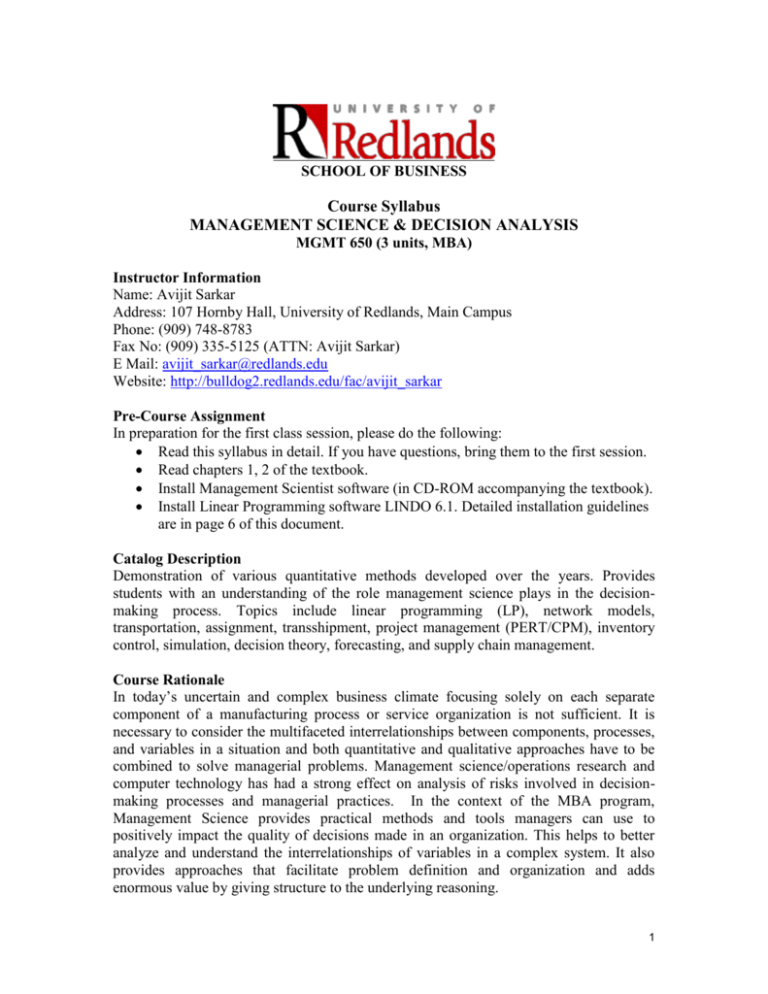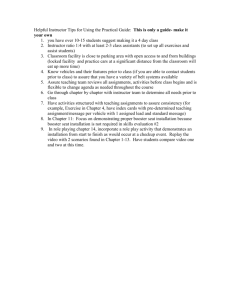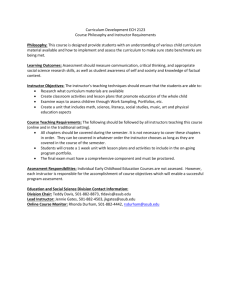- University of Redlands
advertisement

SCHOOL OF BUSINESS Course Syllabus MANAGEMENT SCIENCE & DECISION ANALYSIS MGMT 650 (3 units, MBA) Instructor Information Name: Avijit Sarkar Address: 107 Hornby Hall, University of Redlands, Main Campus Phone: (909) 748-8783 Fax No: (909) 335-5125 (ATTN: Avijit Sarkar) E Mail: avijit_sarkar@redlands.edu Website: http://bulldog2.redlands.edu/fac/avijit_sarkar Pre-Course Assignment In preparation for the first class session, please do the following: Read this syllabus in detail. If you have questions, bring them to the first session. Read chapters 1, 2 of the textbook. Install Management Scientist software (in CD-ROM accompanying the textbook). Install Linear Programming software LINDO 6.1. Detailed installation guidelines are in page 6 of this document. Catalog Description Demonstration of various quantitative methods developed over the years. Provides students with an understanding of the role management science plays in the decisionmaking process. Topics include linear programming (LP), network models, transportation, assignment, transshipment, project management (PERT/CPM), inventory control, simulation, decision theory, forecasting, and supply chain management. Course Rationale In today’s uncertain and complex business climate focusing solely on each separate component of a manufacturing process or service organization is not sufficient. It is necessary to consider the multifaceted interrelationships between components, processes, and variables in a situation and both quantitative and qualitative approaches have to be combined to solve managerial problems. Management science/operations research and computer technology has had a strong effect on analysis of risks involved in decisionmaking processes and managerial practices. In the context of the MBA program, Management Science provides practical methods and tools managers can use to positively impact the quality of decisions made in an organization. This helps to better analyze and understand the interrelationships of variables in a complex system. It also provides approaches that facilitate problem definition and organization and adds enormous value by giving structure to the underlying reasoning. 1 Learning Objectives The main focus of the course will be on: Identifying managerial and organizational problems that can be quantified and analyzed (remembering, recalling, and integrating). Recognizing the integrative aspect of problem solving techniques in an organizational setting (holistic approach and systems thinking). Understanding relationships between variables and factors that affect organizations and firms in a complex situation (interpreting and explaining). Developing and applying models to assist managers and decision-makers in solving organizational problems (synthesizing and implementing). Isolating and analyzing factors in quantitative models that aid managers in making rational decisions (differentiating and organizing; thinking critically). Evaluating and creating various decision-making models within an enterprise (criticizing, judging, and producing). Major Topics Introduction to quantitative analysis Decision analysis (under certainty, risk, and uncertainty) Linear programming (LP), integer LP, sensitivity analysis, and advanced applications Transportation, assignment, and transshipment problems Project scheduling (PERT/CPM) Network models, shortest route, minimal spanning tree, and maximal flow problems Simulation models, stochastic vs. deterministic models, and static vs. dynamic models Forecasting, time series, trend projection, and regression models Supply chain management Text and Software 1. Textbook: An Introduction to Management Science: Quantitative Approaches to Decision Making, Eleventh Edition, by Anderson, Sweeney and Williams, West Publishing Company, 2005. There is also a CD-ROM to accompany the textbook. 2. Software Package: The Management Scientist software (with manual) is included in the Student CD-ROM. Install the software before the first lecture. Installation is crucial for successful completion of homeworks. 3. Linear Programming software LINDO version 6.1: Trial version can be freely downloaded from http://www.lindo.com/downloads/lnd61.exe. Install the software before the first lecture. Installation instructions are in the last page of this document. Installation is crucial for successful completion of homeworks. 2 Dissemination of Information All class material will be posted in Blackboard. As a backup, the same material (apart from HW solutions) will also be posted in the class website (http://bulldog2.redlands.edu/fac/avijit_sarkar). Description of Course Components: The course consists of 5 homeworks, one midterm exam and a final exam. Homeworks There will be 5 challenging homeworks due in sessions 2, 3, 4, 5, 6. Most of these will involve the use of the Management Scientist software and/or LINDO. Each HW will consist of short essay questions, numerical problems and (possibly) a case study. HWs are posted in BB (and also the class website) the day after a class session. They are due on the day of the next class session. Students having “very” similar answers will be penalized as per University policy. After solutions are posted in Blackboard, no HW will be accepted. All HWs must be typed; hand-written homeworks will not be accepted. It is not enough to just state answers of HW questions. No credit will be awarded in such cases. Sufficient detail, proof of steps must accompany solutions. In case of an absence (excused or otherwise), students are responsible for submission of the HW assigned in the class session missed. Make-up HWs will not be provided under any circumstances. Midterm and Final Exam Held in sessions #3 and #6 respectively (approximately 75 minutes duration). Preparation guides will be posted after session #2 and #5. They will contain sample questions and solutions to sample questions apart from other study tips. Format and other issues will be discussed in class Grading Course Component Weight (%) Homeworks 40 Midterm Exam 30 Final Exam 30 Grading Scale 4.0 A 93% - 100% 2.0 C 67% - 69.99% 3.7 A88% - 92.99% 1.7 C64% - 66.99% 3.3 B+ 83% - 87.99% 1.3 D+ 62% - 63.99% 3.0 B 78% - 82.99% 1.0 D 60% - 61.99% 2.7 B73% - 77.99% 0.7 D58% - 59.99% 2.3 C+ 70% - 72.99% 0.0 F below 58% +/- grading scheme will be employed. The instructor reserves the right to deviate from the above-mentioned weights and grading scheme. The students will be informed before hand in such a case. 3 Tentative Course Schedule Session # Preparation For Class Chapters 1 1, 2 Chapters 2 2, 3, 4, 7 3 4 5 6 Chapters 8, 9 Chapters 10, 11 Chapters 14, 16 Chapter 13 Major Topics Review of the syllabus Quantitative analysis Cost, revenue models Introduction to Linear Programming Linear Programming (LP) LP applications Sensitivity analysis in LP Transportation, Assignment Integer Programming applications Shortest path problem Other network models Project Management Inventory Management Forecasting Decision Analysis Simulation Monte Carlo method Assignment Due / Exam Read chapters 1, 2 Install LINDO Install Management Scientist Read chapters 2, 3, 4, 7 HW 1 due Read chapters 8, 9 HW 2 due Midterm Read chapters 10, 11 HW 3 due Read chapters 14, 16 HW 4 due Read chapter 13 HW 5 due Final ACADEMIC HONESTY The University of Redlands Policy on Academic Honesty will be strictly adhered to and applied. The Procedures for Addressing Academic Honesty are set forth in the University of Redlands Catalog. It is expected that all students read and understand the Policy and the provisions outlined in the Catalog. The highest standards of academic conduct are required. This is particularly true for the proper citation of course and research material in all written assignments. Citations (in the form of parenthetical notes, endnotes or footnotes) must be used for quoted or paraphrased text and any time you borrow an idea from an author, the instructor, or your peers. Using someone else’s sentence or organizational structure, pattern of argument and word choice, even if not exactly similar in every respect, warrants citation. It is students’ responsibility to make sure that their citations and quotation marks unambiguously highlight the ideas, words, sentences, and arguments that they borrow from other sources. Paraphrasing is not simply changing one or two words in a sentence; it completely reconstructs someone else’s idea in your own words. For guidelines on appropriate citation, quotation, paraphrasing, and plagiarism, see Diana Hacker’s Writer’s Reference http://www.dianahacker.com/writersref/, materials provided by the Indiana University’s Writing Tutorial Center at 4 http://www.indiana.edu/~wts/pamphlets.shtml, and Harvard University’s Expository Writing Program at http://www.fas.harvard.edu/~expos/index.cgi?section=resources. Discussion with the instructor and your peers is encouraged before the composition of written work; however, all written work, unless specified by the instructor, is to reflect independent composition and revision. Students working on group or collaborative assignments are expected to contribute equally to all tasks necessary for completion of the assignment. Students are expected to follow all written and verbal instructions provided by the instructor with regard to written assignments, quizzes and/or exams. In addition to plagiarism, other impermissible academic behavior includes, but is not limited to, collaboration without instructor consent, falsifying research data, illicit possession of exams, using study aids during exams, unauthorized communication about an assignment or exam, handing in others’ work as your own, reusing assignments or papers from other courses, and impeding equal access to educational resources by other students. Time constraints, the demands of work and family, failing to read the University’s Policy on Academic Honesty, unintentional misuse of sources, or a lack of preparation do not excuse academic dishonesty or otherwise mitigate the appropriate penalty. Penalty for a first offense is at the discretion of the instructor. If a student is uncertain about appropriate methods of citation or has a question about the academic honesty policy, it is his or her responsibility to seek guidance from the instructor, a University official, or another reputable source. Course Policies Class Participation: Class participation and attendance are extremely important, and students must come fully prepared. Due to the accelerated nature of School of Business courses, each class session covers a large amount of material. Students are responsible for all information given during the class instruction. If the student must be absent, he/she should inform the instructor. Unexcused absences (those which are not cleared with the instructor before the class and/or are for reasons other than an emergency) will adversely affect the grade. If the student misses more than two sessions, she/he may not receive credit for the course. Time Management: A minimum of 135 hours should be invested in this 3-unit course. Approximately 24 of these will be in-class contact hours. Students, therefore, should expect to put in the remainder of 18-19 hours/week in reading and preparation outside of the class. Grade of “Incomplete”: An "incomplete" is not given for poor or neglected work. A grade of "incomplete" is to be granted only for very special reasons. The granting of an incomplete grade should occur only after a discussion between faculty and student, initiated by the student. The decision of whether or not to grant an incomplete is dependent on an emergency situation which prevents the student from completing (on time) the work necessary for the course. An incomplete grade will be converted to a permanent grade within eight weeks from the last night of the course. This means that the instructor must turn in the grade to the Registrar no later than the eighth week. Any incomplete work must be submitted to the instructor with enough lead time for the instructor to evaluate the work and issue a grade change. 5 LINDO 6.1 Installation Guidelines You may or may not want to follow the LINDO 6.1 installation instructions below depending upon your level of expertise with software downloads and installation. If you feel comfortable, ignore the following instructions and follow your intuition (this installation is very straightforward), otherwise follow along. 1. Copy http://www.lindo.com/downloads/lnd61.exe to your browser’s address bar and hit Enter. 2. Click “Save” on the File Download window that appears and save the lnd61.exe file to a destination of your choice. 3. Double click lnd61.exe and then click “Run”. 4. Click “Next” and wait for a few seconds. 5. Again click “Next” on the LINDO 6.1 – Installshield Wizard. 6. Accept the license Agreement, i.e., click “Yes”. 7. Select default destination directory, or, browse to any location you want, and then click “Next”. 8. Click “Next” in the following two windows. 9. Click “Finish”. 10. Browse to the location where you saved the LINDO61 directory. 11. Double click and open the LINDO61 directory. 12. Double click the Lindow32.exe icon and a white editor window (like the following) will open up. 13. If you have the previous window, your installation is successful. 6





